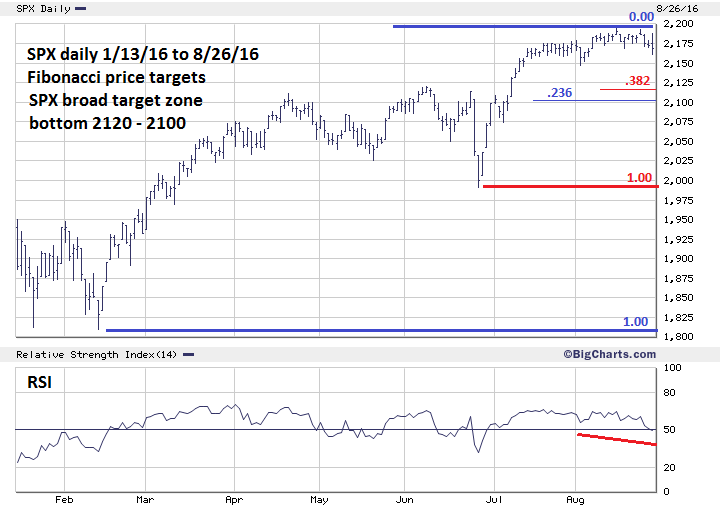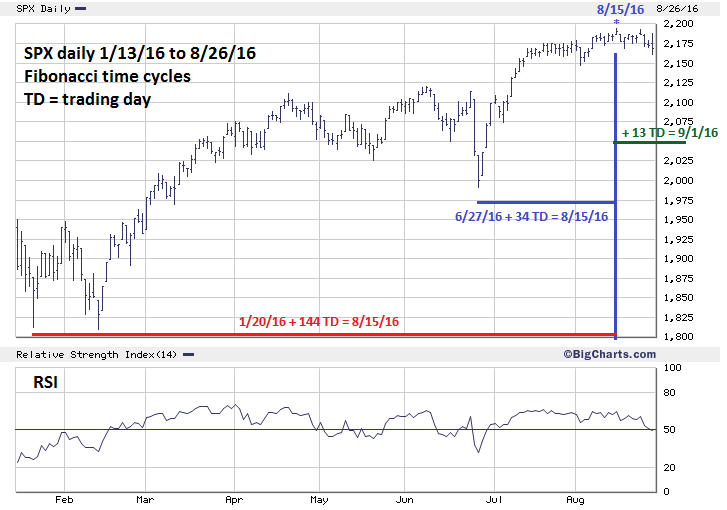This article was written by Mark Rivest, independent investment advisor, trader and writer.
After several weeks of slow movement in the US stock market, Volatility suddenly increased on August 26th with wild swings up and down. The drastic change was triggered by the release of a speech by Fed chair Janet Yellen.
Take the lead from today’s leaders. FM London Summit, 14-15 November, 2016. Register here!
Initially the S&P 500 (SPX) moved down then suddenly had a very fast 14-point rally which was subsequently wiped out, and in the process took out an important double bottom in the SPX 2169 area.
That a powerful move up was quickly reversed indicates a shift in psychology from bull to bear and opens the door for more downside action very soon.
Fibonacci price targets
Using Fibonacci analysis is an incredibly accurate methodology for discovering market support and resistance zones. The recent SPX peak made on August 15th is a good example.
The first phase of the SPX 2016 bull market was from February 11th to June 8th. The peak at 2120.55 minus the February 11th bottom of 1810.10 equals 310.45 SPX points. Multiply 310.45 by the Fibonacci ratio of .618 yields 191.85 SPX points. Adding 191.85 to the June 27th bottom of 1991.67 targets SPX 2183.53. Allowing for leeway is very close to the actual peak made on August 15th at 2193.81
Assuming the August 15th top holds we can use this as the starting point to discover the next correction bottom.
Please see the daily SPX Fibonacci price targets chart in Figure 1.

A Fibonacci .236 retrace of the entire bull move from February 11th to August 15th targets SPX 2103.26
A Fibonacci .382 retrace of the move up from the June 27th bottom to August 15th targets SPX 2116.59 giving a broad target zone of 2120 to 2100.
Within the dimension of market momentum, the daily RSI is forecasting a near term move down. Note that the RSI on August 26th has moved below the level it was at the August 2nd minor bottom. SPX price is still above the August 2nd low of 2147.58, RSI is predicting a near term move below that level.
Fibonacci time targets
R.N Elliott discovered not only the wave principle that’s now named after him but he also discovered that markets sometimes move within increments related to the Fibonacci sequence. The sequence is 1, 1, 2, 3, 5, 8, 13, 21, 34, 55, 89, 144, 233, to infinity.
Please see the daily SPX Fibonacci time targets chart in Figure 2.

There are two Fibonacci time coordinates targeting August 15, as a potential SPX turning day. January 20th bottom plus 144 trading days and June 27th bottom plus 34 trading days.
Adding 13 trading days to August 15th targets September 1st as the next possible market turn which in this case would be a bottom. Very interesting that September 1st is also a new moon. Occasionally markets can turn on either new or full moons.
Summary
Fibonacci price and time analysis are powerful tools that can be used in any market. Even if the SPX fails to reach the price and time targets the tools are still useful because it tells us something else is happening. Investors and traders are always seeking an edge to improve portfolio performance adding Fibonacci analysis can give you that edge.
Further Reading: Frost A.J and Robert Prechter (1985) “Elliott Wave Principle”, New Classics Library.

















